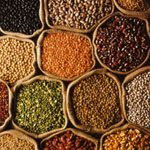|

By December 2027 India is aiming to be self-sufficient in pulses and imports will stop.
2016 was the International Year of Pulses (IYP) promoted by the Food & Agriculture Organisation of the United Nations to heighten public awareness of the benefits of pulses as part of sustainable food security and nutrition. IYP in collaboration with governments, relevant organisations including NGOs and other stakeholders, created this unique opportunity to encourage connections throughout the food chain that would better utilise pulse-based proteins, further global production of pulses, better utilise crop rotations and address the challenges in the trade.
Pulses are derived from legumes and are high in protein and fibre, and low in fat. They form a vital part of a healthy diet.
Legumes are:
• Pulses – dried Beans, dried Peas, Chickpeas and Lentils
• Fresh Peas and fresh Beans (in pods)
• Soybeans, Peanuts
Dals cover dried pulses, lentils, peas and beans, stripped of their outer hulls, and split.
Beauty Without Cruelty was surprised beyond words to be told that dals are polished with leather but upon investigation, we discovered it was so! A particular brand was marketing unpolished dals claiming “we do not add marble powder (very harmful for intestines), oil polish (added fat), water polish (source of water is unknown) or leather belt polish (animal skin touch)”.
Pictures of a dal polishing machines with leather belts were found on the internet so we got initial proof of dals being polished with leather.
An inquiry was first made with a dal mill owner in Gujarat. It was orally learnt – hold your breath – that tiger skin was used, especially to polish moong dal. Difficult to believe, given the protected status of the tiger in India, but we were emphatically told that tiger skins are commonly used for this purpose in North Indian mills. Our efforts to confirm this or to trace the supply source of the skins have not been successful.
BWC then wrote to the India Pulses and Grains Association (Mumbai) and 28 manufacturers. Not one of them responded, thus indirectly proving that pulses and grains are polished with leather.
We then wrote to the Indian Institute of Pulses Research at Kanpur. The explanation received from Prasoon Verma, Scientist-SG(ASPE) is reproduced below:
“Regarding polishing of pulses, it is to inform that first grade dal (dehusked splits) is never polished. Polishing, though not recommended, is done for second and third grade dal. Edible oil, colour and powder are used to improve appearance of the product. Commonly leather belts are used for rubbing dal against screen to give shine and uniform look. Polishing is avoidable as thorough washing before cooking is required for polished dal. However, it is claimed that polishing improves storability of dal. Polishing is not an essential operation for any pulse.” |